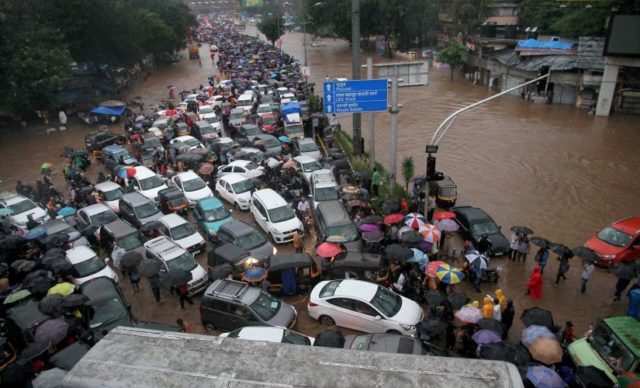Singing in the Rain is perhaps Hollywood’s most beloved musical comedy. An effervescent blend of music, dance and acting, the Gene Kelly – Debbie Reynolds starrer is certainly a classic, and the title song evokes the best of a city in the rainy season, as Kelly swivels around lamp-posts and dances around puddles.

For Mumbai, sadly, the rainy season has long been associated with far less happy memories. Instead of bright love songs, we sing dirges, and anything more than a drizzle evokes nothing but dread.
Catastrophic rain-caused flooding is not new to the city, I suppose. Scarce a year has passed since my childhood when heavy rains have not led to cancellation of school / college / office for at least one day.
But for the generation that was born in the 1980’s, the most significant date will always be the 26th of July, 2005. It was a day when the skies really opened up, with more than 900 mm of rain falling on a single day. Roads went under, barricades went under, cars went under, even buses – yes, buses – went under the burgeoning water. It was over ten days before things became quite normal in some parts of the city, and official estimates speak about close to 1,500 people losing their lives.
On August 29th this year, that sad saga seemed likely to repeat itself. Another torrential deluge, another breakdown of Mumbai’s infrastructure, another set of horror stories emerging. This time, the devastation was less pronounced, mostly due to the volume or rain being about one-third of what it had been the previous time. And yet, roads were clogged, property was damaged, and people lost their lives.
2017 was especially damning because, of course, 2005 had already happened. After that disaster, money was poured into improving Mumbai’s storm-water drainage, restoring the Mithi river and making the city ‘disaster-ready’. Instead, this year proved, as many intervening years had to a lesser degree, that the money might as well have been put directly into the Mithi river itself.
This year the same excuses are being trotted out, the same blame game being played between the various agencies responsible for Mumbai’s well-being, from the BMC to the MMRDA to NHAI.
All said and done, however, there are certain measures that need to be taken promptly in order to prevent a repeat of such disasters:
1. Improve storm warning system: A better way to predict and disseminate information relating to potential flooding needs to be a top priority.
2. Modify homes and businesses: Low-lying homes and shops and factories need to be water-proofed and electrical outlets re-wired to make them water-safe. This is especially significant in low-income housing where a bulk of family assets are retained at home.
3. Construct buildings above water level: While this is usually followed in new constructions, it would help to make it a norm for new buildings to be above flood-water level.
4. Protect mangroves: This is absolutely essential for Mumbai which has a mangrove-based natural defence against flooding. This needs to be preserved.
5. Restore rivers to the natural courses: The work to de-silt and purify the Mithi river needs to be undertaken with all seriousness and from a water-drainage perspective. Mumbai’s only river has reduced to a nullah and we are all poorer for it.
6. Introduce civic responsibility among the citizenry: Perhaps the hardest of all to implement, for Mumbai-kars have become far too used to complaints without taking responsibility for their own actions. Littering, especially, is a prime cause of drain blockage in the city, and it is necessary for the citizens of Mumbai to gain a consciousness of the consequences of their actions that hinder the authorities’ efforts to control the infrastructure.
Finally, keeping the city safe and running is a collective responsibility for the people who live in it and those who run it. The rain itself is a natural phenomenon that does not choose when and where to fall. It is for us to learn how to best manage the consequences of it.





















